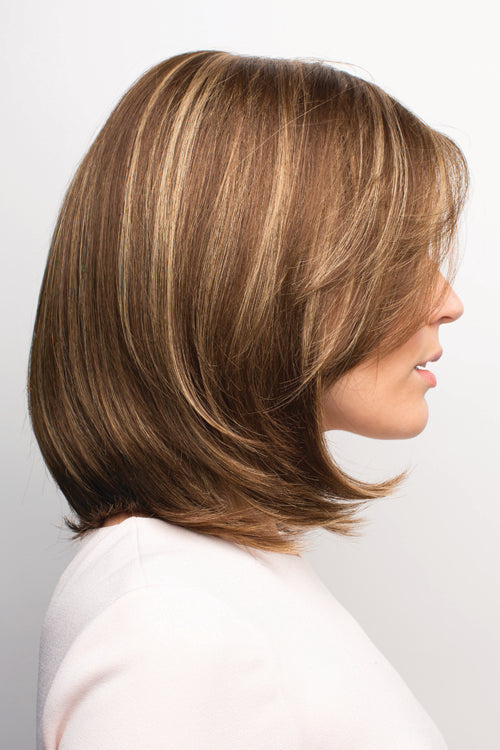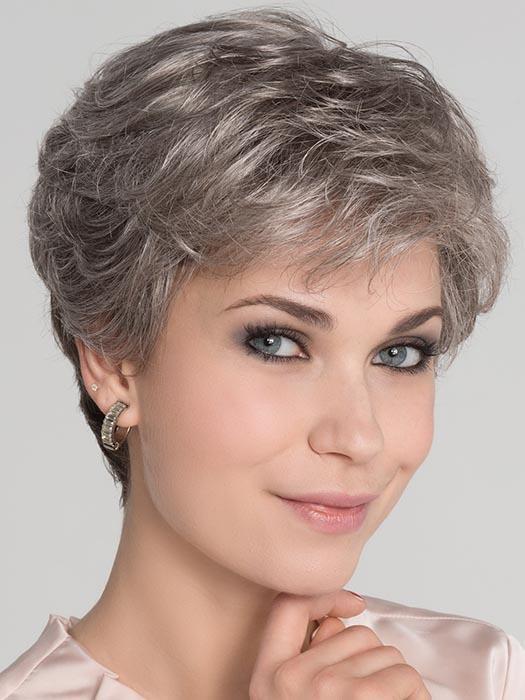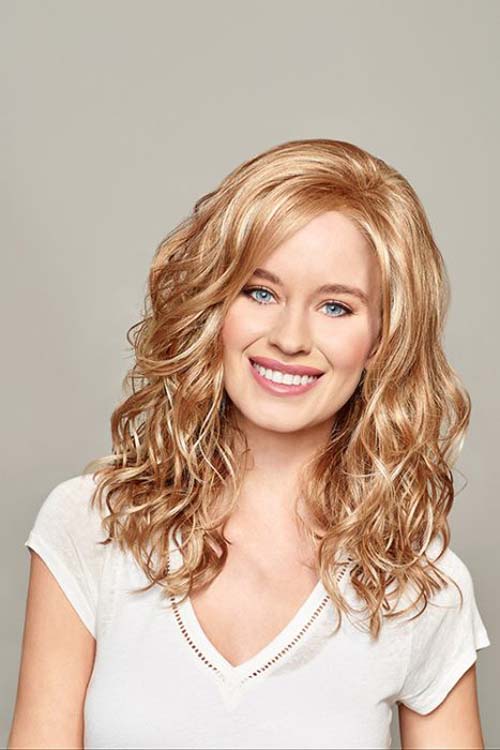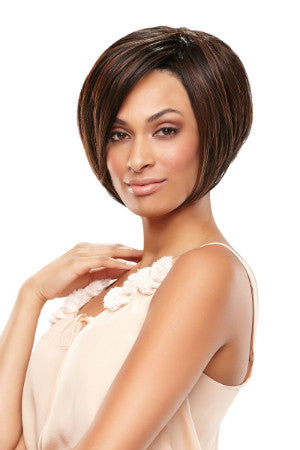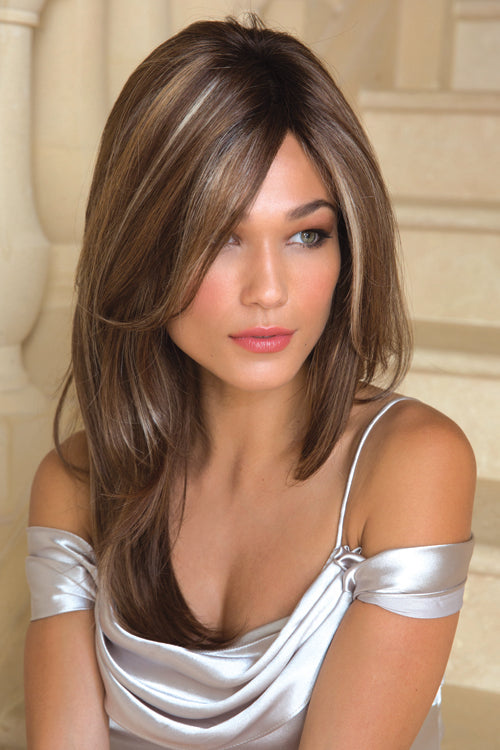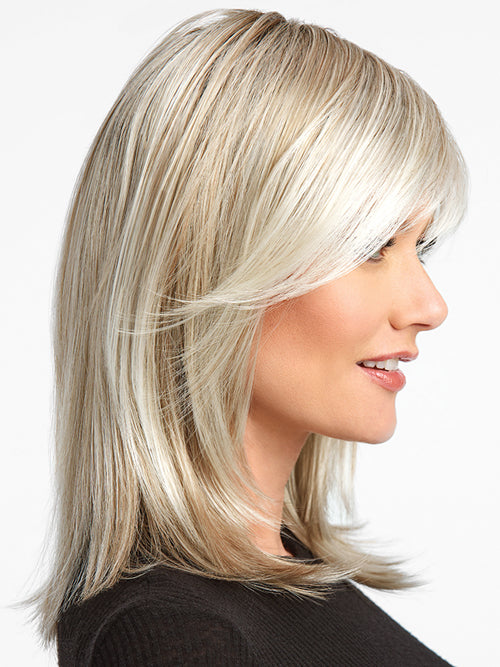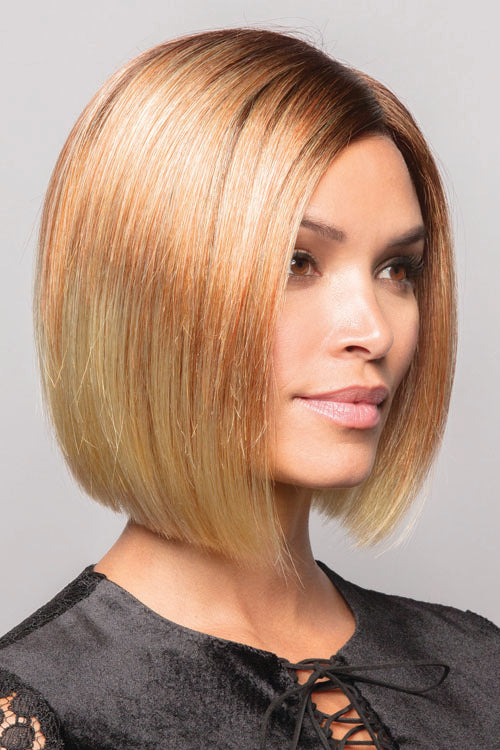Table of contents
Choosing the perfect color when shopping for women’s wigs can feel overwhelming—especially when you’re faced with a string of numbers, letters, and names like 6F27, RL12/22SS, or R8/26H. If you’ve ever wondered what these codes actually mean, you’re not alone.
Wig color codes are essential for understanding the subtle differences between shades, highlights, and root colors. In this guide from Women’s Wig Shop, we explain how wig color charts work so you can find wigs for women that work best for you.
Are Wig Color Codes Universal?
The short answer is: not entirely. While many wig brands are inspired by the same basic hair color numbering system used in salons (where numbers like 1 represent jet black and 613 indicates pale blonde), there is no single, standardized wig color code system used industry-wide.
Most brands start with similar base numbers to represent core shades—like browns, blondes, blacks, and reds—but each brand adds its own suffixes, blends, and naming conventions. Because of these inconsistencies, the same color code might look completely different between wig brands.
Common Wig Color Code Terminology
Understanding wig color chart codes starts with knowing the basic components: numbers, letters, and descriptive terms. Here's a breakdown of what these codes often mean so you can feel more confident when choosing your wig shade.
Base Color Numbers
Most wig color codes begin with a number or a set of numbers that represent the base color.
Here’s a simplified guide of some of the most common wig color codes:
- 1 – Jet Black: Deepest black available
- 2 – Darkest Brown: Almost black, very deep brown tone
- 4 – Dark Brown: Rich chocolate brown
- 6 – Medium Brown: Neutral medium shade of brown
- 8 – Light Brown: Lighter chestnut tone with warmth
- 10 – Lightest Brown: On the edge between brown and dark blonde
- 12 – Light Golden Brown: Warm honey brown tones
- 14 – Dark Ash Blonde: Cool beige-blonde with less warmth
- 16 – Ash Blonde: Light and cool-toned blonde
- 18 – Light Ash Blonde: Even lighter and icier than 16
- 22 – Champagne Blonde: Pale, soft cool blonde
- 24 – Golden Blonde: Bright, sunny warm blonde
- 27 – Strawberry Blonde: Reddish-golden blonde hue
- 28 – Copper Blonde: Warm, golden red-blonde with rich copper undertones
- 30 – Medium Auburn: Warm, medium red-brown shade
- 33 – Dark Auburn: Deep red with brown undertones
- 130 – Copper Red: Vivid, bright copper tone
- 613 – Pale Blonde: Almost platinum, very light blonde
Common Letter Suffixes
These letters are often added to base color numbers to indicate special effects, blends, or color placement. Each brand may interpret them slightly differently, but here's what they typically mean:
- R – Rooted: Darker roots for a natural, grown-out appearance
- H – Highlighted: Lighter strands blended throughout the base for added dimension
- F – Frosted: Streaks of a lighter color evenly distributed throughout the wig
- T – Tipped: Ends of the hair are lightened or colored differently from the roots
- S – Streaked or Special blend: Intentional streaks of contrast color or a unique color technique
- B – Blend: A mixture of two or more tones smoothly combined for a natural look
- SS – Shaded or Shadowed Root: A brand-specific rooted effect
- GR or GL – Gradient Root or Gradient Layer: Soft transition from darker roots to lighter ends, often with layered color effects
- C – Chunky: Bolder, more defined highlights
Descriptive Color Names
Some brands use descriptive names instead of codes—or alongside them. These names often sound like cosmetics or coffee, and while they don’t explain the exact color formula, they give a good idea of the overall tone. Look at the examples below to get a feel for the types of names and how they represent a specific color type.
Blondes
- Shaded Biscuit: Cool, beige blonde with darker roots
- Champagne-R: Pale, neutral blonde with rooted base
- Spring Honey: Light golden blonde with honey undertones
Browns
- Iced Mocha: Medium brown with icy blonde highlights
- Maple Sugar: Light brown with golden blonde highlights
- Hazelnut: Warm brown with auburn and caramel tones
Reds
- Dark Rust: Deep copper-red blend
- Cherrywood: Bold red with brown undertones
- Sunset Red: Bright, fiery red-orange hue
Grays
- Silver Stone: Soft silver with hints of light brown at the roots
- Moonstone: Cool platinum with white-blonde blend
- Iced Gray: Bright white-gray with a hint of cool tone
Fashion Colors
- Plumberry Jam-LR: Deep burgundy with dark rooted base
- Blueberry Burst: Bold blue with soft black undertones
- Rose Gold-R: Light pink-gold with a rooted base for dimension
How to Read a Wig Color Chart
Understanding wig color chart codes becomes much easier when you see how the pieces come together. Below are three examples that break it down step by step—so you can feel more confident when reading wig shades online.
Jon Renau 12FS8, “Shaded Praline”
-
Step 1: Identify the base color, which is the foundation of the wig color.
12 = Light golden brown -
Step 2: Look for letter suffixes that describe how the color is applied.
FS = Fashion Syrup (Jon Renau’s term for bold, chunky highlights) -
Step 3: Note the root shade, which gives the wig a more natural appearance.
8 = Medium brown root
The Result: A soft, dimensional blonde with warm golden highlights and shaded medium brown roots for a realistic, sun-kissed finish.
Estetica R6/28F
-
Step 1: Identify the base color.
R6 = Dark brown -
Step 2: Find the secondary color after the slash, indicating the highlight shade.
28 = Copper blonde -
Step 3: Decode the letter suffix.
F = Frosted, provides light streaks of highlights distributed throughout the base.
The Result: A rich brunette base with warm copper highlights softly blended throughout, offering warmth and natural brightness.
Raquel Welch 33/32C, “Cherry Merlot”
-
Step 1: Identify the base color.
33 = Dark auburn -
Step 2: Identify the blended or highlighted color.
32 = Medium auburn -
Step 3: Interpret the letter suffix for highlight style.
C = Chunky, giving bolder, more defined highlights.
The Result: A vibrant red combination with high contrast between deep auburn and lighter red tones, creating a bold, eye-catching dimension.
Wig Color Charts by Brand
Because wig color codes aren’t universal, it’s important to reference the specific color chart for the brand you're shopping for. Below is a guide to how each brand carried by Women’s Wig Shop presents its colors to customers.
Amore
The Amore Collection is known for its realistic colors that enhance the natural appearance of hair fibers.
Example: Samantha Synthetic Wig
If you’re looking at the Samantha wig by Amore, you might notice that the color options don’t include long codes or numbers like some other brands. That’s because Amore uses descriptive color names instead of traditional color codes.
Color Examples:
Ellen Wille
Ellen Wille Collection is recognized for its sophisticated, European-inspired shades with soft rooting and natural tonal depth.
Example: Apart Synthetic Wig
With the Apart wig by Ellen Wille, you’ll find that the color names focus more on descriptive blends like “Salt Pepper Mix” or “Smoke Mix” rather than using numeric codes.
Color Examples:
Estetica
The Estetica Collection color palette features rich, multi-dimensional tones that balance subtle highlights with wearable everyday hues.
Example: Becky Synthetic Wig
With the Becky wig by Estetica, you’ll notice that the color names often describe both the base and technique—like “Golden Blonde Blended n Tipped w Ash Blonde,” though Estetica’s approach makes it simple to visualize the color without needing to decode number systems. However, there are corresponding numbers as reference.
Color Examples:
Gabor
The Gabor Collection offers soft, flattering colors with gradient blends and rooted effects designed for timeless, age-inclusive styles.
Example: Sheer Elegance Synthetic Wig
With the Sheer Elegance wig by Gabor, you’ll see names like “SS Buttered Biscuit” and “Walnut” as reference alongside wig color codes. Gabor uses intuitive, soft shade names, and colors marked “SS” feature natural-looking shaded roots.
Color Examples:
Henry Margu
When shopping for the Harper wig by Henry Margu, you’ll encounter colors like “Light Wheat Blonde with Light Gold Blonde Highlights” or “Dark Brown with Black Roots.” This brand favors clear, sentence-style descriptions that detail both the tone and highlight technique.
Example: Harper Synthetic Wig
Henry Margu uses descriptive, sentence-style color names detailing tone and highlight techniques.
Color Examples:
Jon Renau
Looking at the Ignite wig by Jon Renau, you may see a mix of numeric and named shades, like “Hot Fudge” or “Chocolate Cherry.” While some colors use number-letter codes, many are labeled with intuitive names that reflect the shade’s mood or tones.
Example: Ignite Heat-Defiant Synthetic Wig
Shade names range from numeric codes to intuitive, mood-based names.
Color Examples:
Noriko
The Noriko Collection stands out for its high-contrast highlights and vibrant blends, offering bold, dimensional color options.
Example: Shilo Synthetic Wig
The Shilo wig by Noriko is a long, offers vibrant color blends like “Nutmeg F” or “Creamy Blond.” Noriko leans toward descriptive names with suffixes like “F” for frosted, giving you insight into highlight styles without needing to interpret numbers.
Color Examples:
Raquel Welch
The Raquel Welch Collection colors are inspired by professional salon techniques, with glazed highlights, shaded roots, and polished finishes.
Example: Watch Me Wow Synthetic Wig
The Watch Me Wow wig by Raquel Welch offers richly styled color names such as “Glazed Strawberry” and “Shaded Cocoa.” The brand’s shades reflect salon techniques, with terms like “glazed” (highlighted) and “shaded” (rooted) built right into the name.
Color Examples:
Rene of Paris
The Rene of Paris Collection is celebrated for its creative color names and trend-setting shades, ranging from natural melts to bold fashion hues.
Example: Kai Synthetic Wig
With the Kai wig by Rene of Paris you’ll find trend-driven colors like “Melted Marshmallow” and “Mochaccino LR.” These names are vivid and descriptive, with suffixes like “LR” meaning Long Rooted for a more natural root fade effect.
Color Examples:
Additional Tips for Choosing the Right Wig Color
- Match your wig shade to your skin’s undertone—warm, cool, or neutral.
- If you’re new to wigs, choose a color close to your natural hair.
- Rooted shades (marked “R,” “SS,” or “LR”) look more natural at the scalp.
- Wig colors can look different in indoor vs. natural lighting.
- Don’t rely on color names alone—check the swatches and photos.
- Ask our customer support team for help choosing a wig shade.
Contact Us Today for Help Choosing Your Next Wig Color
Still unsure which shade is right for you? Our team at Women’s Wig Shop is here to help you decode the many colors involved when shopping for wigs for women. Whether you need color comparisons or personalized recommendations, we’re happy to guide you every step of the way.

